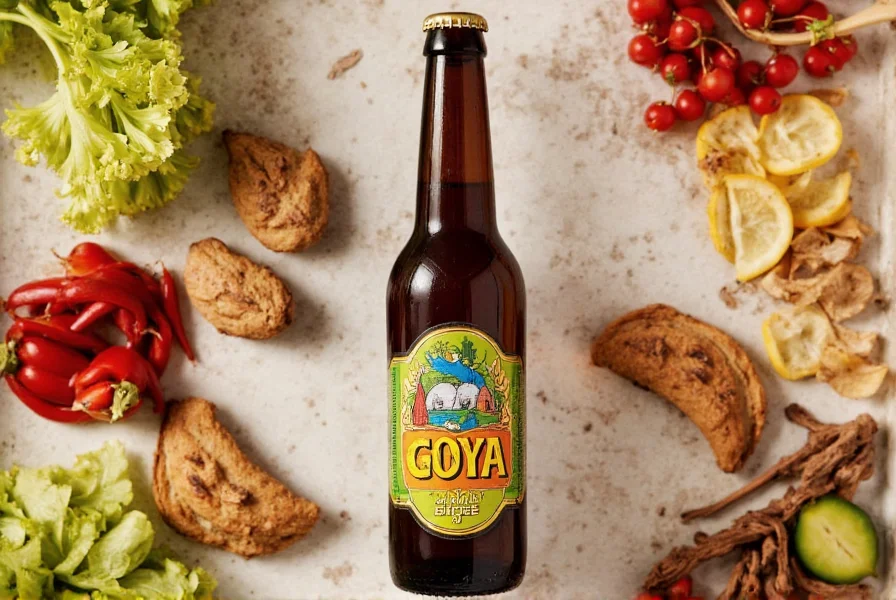Goya ginger beer stands out in the crowded ginger beverage market as a reliable, consistent option rooted in Caribbean and Latin American culinary traditions. This carbonated soft drink delivers a distinctive spicy-sweet flavor profile that has made it a pantry staple for home cooks and bartenders seeking authentic island-inspired beverages without alcohol content.
Understanding Goya Ginger Beer's Unique Profile
When examining goya ginger beer ingredients, you'll find carbonated water, high fructose corn syrup, ginger root extract, citric acid, sodium benzoate (as preservative), and natural flavors. The ginger root extract provides the signature spicy kick, while the sweeteners balance this heat with noticeable sweetness. Unlike artisanal fermented ginger beers that develop natural carbonation and trace alcohol through yeast activity, Goya's version achieves carbonation through forced injection, resulting in a consistently non-alcoholic product.
How Goya Compares to Other Ginger Beers
Understanding the difference between goya ginger beer vs regular ginger beer requires examining production methods. Traditional ginger beer undergoes fermentation, potentially yielding 0.5-3% alcohol content, while Goya's version is strictly non-alcoholic. This makes it suitable for children, designated drivers, and those avoiding alcohol for religious or health reasons.
| Feature | Goya Ginger Beer | Craft Fermented Ginger Beer |
|---|---|---|
| Alcohol Content | 0% ABV | 0.5-3% ABV |
| Carbonation Method | Forced injection | Natural fermentation |
| Ginger Intensity | Moderate spice | Variable (often stronger) |
| Availability | Nationwide supermarkets | Specialty stores, breweries |
Practical Uses in Cooking and Mixology
Chefs and home cooks value Goya ginger beer for its consistent flavor in goya ginger beer uses in cooking. The beverage works exceptionally well as:
- A base for Caribbean-style ginger beer-braised meats
- A non-alcoholic alternative in mocktails and punches
- A marinade component for poultry and fish
- A flavor enhancer in fruit salads and sorbets
Professional mixologists often reach for Goya when creating alcohol-free versions of classic cocktails like the Moscow Mule or Dark and Stormy. Its reliable sweetness level and ginger spice make it predictable in recipe development—something small-batch fermented ginger beers can't always guarantee due to natural variation between batches.
Nutritional Profile and Dietary Considerations
Examining goya ginger beer nutrition facts reveals important information for health-conscious consumers. A standard 12-ounce serving contains approximately 160 calories, 42 grams of carbohydrates (all from sugars), and no fat or protein. While it delivers genuine ginger flavor, it lacks the probiotic benefits found in fermented ginger beers due to its production method.
Those managing diabetes or reducing sugar intake should note that Goya ginger beer contains high fructose corn syrup as its primary sweetener. For a lower-sugar alternative, some consumers dilute it with sparkling water or use it sparingly as a flavoring agent rather than consuming it straight.

Finding and Selecting Goya Ginger Beer
When searching for where to buy goya ginger beer, check the international foods section of major supermarkets like Walmart, Target, and Kroger. Latin American and Caribbean specialty markets almost always carry it, typically priced between $1.50-$2.50 per 12-ounce bottle. The product comes in both glass bottles and larger plastic containers, with the smaller bottles offering better flavor preservation.
When selecting Goya ginger beer, check the expiration date as the ginger flavor can diminish over time. The beverage should have a vibrant amber color and vigorous carbonation when poured. If the liquid appears cloudy or lacks fizz, the product may be past its prime.
Authenticity in Caribbean and Latin American Cuisine
Goya ginger beer occupies a special place in Caribbean culinary traditions, particularly in islands like Jamaica, Trinidad, and Barbados where ginger-based beverages have cultural significance. While not as intensely spicy as some regional homemade versions, Goya provides a consistent approximation that works well in traditional recipes calling for ginger beer.
Chefs preparing authentic Jamaican ginger beer punch or Trinidadian sorrel drink often prefer Goya for its reliable flavor profile and wide availability. The beverage's moderate spice level makes it versatile for both drinking straight and incorporating into recipes where an overwhelming ginger flavor might dominate other ingredients.
Storage and Serving Recommendations
For optimal flavor, store Goya ginger beer in a cool, dark place away from direct sunlight. Once opened, transfer to an airtight container and refrigerate, consuming within 3-4 days as carbonation will dissipate. Serve chilled over ice for maximum refreshment, or warm gently (without boiling) for a soothing ginger beverage during colder months.
Common Substitutes When Goya Is Unavailable
If you're wondering about best substitutes for goya ginger beer, consider these alternatives:
- Canada Dry Ginger Ale - Less spicy but widely available
- Reed's Zero Alcoholic Ginger Beer - Stronger ginger flavor, higher price point
- Homemade ginger syrup diluted with soda water - More labor-intensive but customizable
- Barritt's Ginger Beer - Closer to craft ginger beer with slightly higher spice level
Each substitute brings different characteristics to recipes, so choose based on whether you prioritize ginger intensity, sweetness level, or carbonation strength for your specific application.










 浙公网安备
33010002000092号
浙公网安备
33010002000092号 浙B2-20120091-4
浙B2-20120091-4